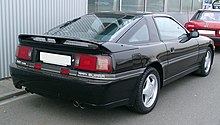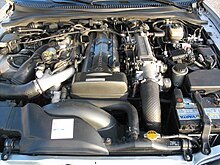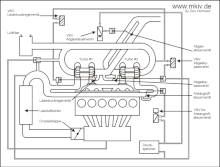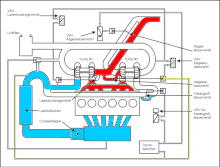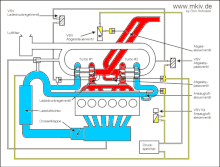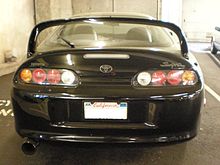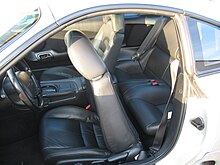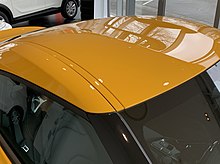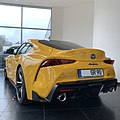Toyota Supra
| Toyota (Celica) Supra | |
|---|---|
| Production period: | 1978–2002, since 2019 |
| Class : | Sports car |
| Body versions : | Combi coupe |
Toyota Supra is a sports car from the Toyota company , which was first developed as a derivative of the Coupé Celica (as Celica Supra ) presented in autumn 1970 and marketed as an independent model from the beginning of 1986. The addition “Supra” (above, superordinate) should clarify the prominent positioning.
Celica XX Supra (1978-1981)
The first Supra, built from the spring of 1978 to the summer of 1981, was still offered as the top-of-the-line version of the Celica, first in Japan and later in the USA.
The model officially called Celica XX Supra was offered with the 2.6-liter six-cylinder engine (4M-E) and 82 kW (110 PS). This is a SOHC engine with 2-valve technology and conventional coil ignition (battery ignition). In some regions, the 2.0-liter six-cylinder M-TE engine with turbocharging with 108 kW (145 hp) was also available.
Other differences to the normal Celica were an extended wheelbase (the car was extended in front of the passenger cell), more extensive equipment and light alloy cylinder heads on the engine side with two overhead camshafts and intake manifold injection . In addition, the front has been modified and the grill is designed in the shape of a "T".
Celica Supra (MA 60/61, 1981–1985)
| 2nd generation | |
|---|---|
|
Toyota Celica Supra (1981–1985) |
|
| Production period: | 1981-1985 |
| Body versions : | Combi coupe |
| Engines: |
Petrol engines : 2.8 liters (125 kW) |
| Length: | 4620 mm |
| Width: | 1685-1720 mm |
| Height: | 1321 mm |
| Wheelbase : | 2614 mm |
| Empty weight : | ≈1250 kg |
The second generation was presented in autumn 1981.
It was also still recognizable as a derivative of the Celica Liftback, but with the new 125 kW (170 PS) 2.8-liter 6-cylinder engines 5M-GE and 5M-E (both for Europe) it had a completely independent one Drive. Visually, the Celica Supra was distinguished by the wider B-pillar and the differently shaped front.
Further model and performance variants were offered in the USA and Japan. The special features included the four internally ventilated disc brakes, power steering and limited-slip differential .
The Celica Supra, which was initially offered in Switzerland, was powered by the 5M GE engine with 125 kW (170 PS). Due to differing emissions regulations, it was offered from the beginning of 1984 with the 5M electric motor from the Toyota Crown with 103 kW (140 PS). With the 5M-GE engine, it was only imported into Switzerland for a year. The version with the 5M electric motor now had a catalytic converter, which was missing in the 5M GE motor.
In Europe (except in Sweden and Switzerland) the Celica Supra was further equipped with the 5M-GE engine. In 1984 this engine experienced a small increase in output to 133 kW and, like the Swedish and Swiss versions, a digital speedometer with tachometer.
Production was stopped in the summer of 1985.
5M-GE engine (1981–1985)
- Engine: 6-cylinder in-line engine with two overhead camshafts, electronic manifold injection (EFI), contactless transistor ignition.
- Bore × stroke: 83.0 × 85.0
- Cylinder head: 12 valves
- Displacement: 2740 cm³
- Compression: 9.2: 1
- Output: 125 kW (170 hp) at 5600 rpm
- Torque: 230 Nm at 4600 rpm
Driving performance with 5M-GE engine (125 kW / 170 PS)
- Top speed: 210 km / h
- 0 to 100 km / h: 8.7 seconds
- Consumption: 10 l
Transmission manual
- 5 gears manual
- Toyota gearbox code: W 58
- Translation:
- 1st gear: 3.268
- 2nd gear: 1.894
- 3rd gear: 1.276
- 4th gear: 1,000
- 5th gear: 0.861
- Reverse: 3,769
- Clutch: hydraulically operated single-plate dry clutch
- Drive: rear axle, limited slip differential
Automatic transmission
- 4-stage automatic
- Translation:
- 1st stage 2,452
- 2nd stage 1.452
- 3rd level 1,000
- 4th level 0.688
- Reverse gear: 2.212
landing gear
Rear-wheel drive, all-round independent suspension, MacPherson struts and wishbones at the front, semi- trailing arms at the rear ; Rack and pinion steering with power assistance, hydraulic dual-circuit brake with brake booster, internally ventilated disc brakes at the front and rear.
- Rim size front and rear: 6J × 15 "
- Tire size: 205/60 VR 15
Furnishing
Limited slip differential, aluminum rims, oil cooler, headlight washer system, fog lamps and tail light, 8-way adjustable driver's seat, sports seats, electric windows, adjustable steering wheel.
Supra (MA70 / MA71, 1986-1992)
| 3rd generation | |
|---|---|
|
Toyota Supra (1986-1992) |
|
| Production period: | 1986-1992 |
| Body versions : | Combi coupe |
| Engines: |
Petrol engines : 2.0-3.0 liters (150-206 kW) |
| Length: | 4620 mm |
| Width: | 1745 mm |
| Height: | 1301-1310 mm |
| Wheelbase : | 2595 mm |
| Empty weight : | 1530-1595 kg |
The third generation of the Supra was presented in early 1986. It is also the first that was no longer marketed with the addition of Celica. The final separation of the two model series was made clear by the drive concept (the Celica was sold with front-wheel drive from 1986, the Supra remained with rear-wheel drive) and the design. The third Supra is also known by the nickname "Antelope".
The turbo engine with 173 kW (235 hp) appeared in autumn 1987.
A first facelift on the front and rear (three-part rear wing) was carried out in August 1988. At the same time, the naturally aspirated engine was taken out of the range.
A second revision (different Toyota emblem and 5-star rims) took place in spring 1991. In terms of engine technology, the engine received hardly any noteworthy 2 kW (3 PS) and 6 Nm more and thus "strengthened" to 175 kW (238 PS) and 350 Nm.
From this generation there was also a variant with a Targa roof , which was offered as an alternative on certain markets, but also as the only body version in some cases (as in Germany). In Japan and the USA , a variant with a sun roof was also offered.
There was also a homologation model of the MA70 limited to 500 pieces called Turbo-A (7M-GTE Turbo A). This was necessary because the Group A regulations of the time stipulated this if a modified turbocharger and / or other assemblies were to be used. The Turbo-A models developed 204 kW (270 hp) and were only sold in Japan.
At the end of 1992, production of the third series ended.
Problems
The turbo engine had to struggle with technical problems due to the often defective cylinder head gasket and was therefore not very stable and reliable. The turbocharger was mounted on the existing engine without reinforcing the remaining components accordingly. Many owners of the turbo models therefore had engine problems and blown seals up to engine damage due to overheating.
Engines
- 1G-GTE: 2.0 l twin turbo, 6 cylinders, 153 kW / 208 PS (most powerful version of the 1G-GTE)
- 1JZ-GTE: 2.5 l twin turbo, 6 cylinders, 206 kW / 280 PS; Version for Japan
- 7M-GE: 3.0 l, 6 cylinder, 150 kW / 204 PS (01.1986-08.1988)
- 7M-GTE: 3.0 l turbo, 6 cyl., 173 kW / 235 PS (09.1987–01.1991)
- 7M-GTE: 3.0 l turbo, 6 cyl., 175 kW / 238 PS (01.1991–12.1992)
- 7M-GTE Turbo A: 3.0 l Turbo, 6 cyl., 204 kW / 277 PS; Limited special model in Japan
7M-GTE engine (09.1987–01.1991)
- Engine: 6-cylinder in-line engine with turbocharger and two overhead camshafts
- Bore × stroke: 83.0 × 91.0
- Cylinder head: 24 valves
- Displacement: 2954 cm³
- Compression: 8.4: 1
- Output: 173 kW (235 hp) at 5600 rpm
- Torque: 344 Nm at 3200 rpm
7M-GTE engine (01.1991–12.1992)
- Engine: 6-cylinder in-line engine with turbocharger and two overhead camshafts
- Bore × stroke: 83.0 × 91.0
- Cylinder head: 24 valves
- Displacement: 2954 cm³
- Compression: 8.5: 1
- Output: 175 kW (238 hp) at 5600 rpm
- Torque: 350 Nm at 3200 rpm
Transmission manual
- 5 gears manual
- Toyota gearbox code: R154 (Turbo)
- Toyota gearbox code: W 58 (without turbo)
- Translation:
- 1st gear: 3.251
- 2nd gear: 1.955
- 3rd gear: 1.310
- 4th gear: 1,000
- 5th gear: 0.753
- Reverse gear: 3.180
- Clutch: hydraulically operated single-plate dry clutch
- Drive: rear axle, 25% locked differential
Automatic transmission
- 4-stage automatic (turbo)
- Toyota gearbox code A340
- Translation:
- 1st stage 2.804
- 2nd stage 1.531
- 3rd level 1,000
- 4th level 0.705
- Reverse gear: 2.393
Weights
- Empty weight: 1550 kg (manual) | 1630 kg (automatic)
- permissible total weight: 2070 kg
- Payload 530 kg (manual) | 505 kg (automatic)
- Front axle load: 1120 kg
- Rear axle load: 1120 kg
- Trailer load restrained: 1700 kg
- Trailer load without brakes: 600 kg
- Roof load: 100 kg
body
- Concept: four-seater coupe with two doors and a tailgate
- Dimensions
- Length: 4630 mm
- Width: 1745 mm
- Height: 1310 mm
- Tank capacity: 70 liters
landing gear
Rear-wheel drive, all-round independent suspension with double support; Rack and pinion steering with power assistance, hydraulic dual-circuit brake with brake booster, internally ventilated disc brakes at the front and rear, ABS.
- Rim size front and rear: 7J × 16 "
- Tire size: 225/50 R 16
Performance (turbo model)
- Top speed: 245 km / h
Acceleration:
- 0–60 km / h: 3.4 s
- 0–80 km / h: 5.0 s
- 0-100 km / h: 6.3 s
- 0–120 km / h: 9.5 s
- 0–140 km / h: 12.4 s
- 0–160 km / h: 16.4 s
- 0-200 km / h: 28.4 s
- 400 meters (standing start): 14.8 s
- 1 kilometer (standing start): 26.9 s
- Elasticity 60–100 km / h (4th gear): 6.2 s
- Elasticity 80–120 km / h (5th gear): 9.9 s
Furnishing
ABS, 25% locked differential, oil cooler, headlight washer system, central locking, fog lamps and -Schlussleuchte, seat heating (as an option), cruise control, Targa roof (in turbo series), sunlight-dependent automatic air conditioning, electrically adjustable driver's seat, power windows, power mirrors, adjustable steering wheel .
Supra (JZA80, 1993-2002)
| 4th generation | |
|---|---|
|
Toyota Supra (1993-2002) |
|
| Production period: | 1993-2002 |
| Body versions : | Combi coupe |
| Engines: |
Petrol engines : 3.0 liters (162–243 kW) |
| Length: | 4515 mm |
| Width: | 1810 mm |
| Height: | 1275 mm |
| Wheelbase : | 2550 mm |
| Empty weight : | 1590-1640 kg |
In July 1993 the fourth generation of the Supra came onto the market (model code JZA80). Internationally this type is called “Supra MKIV” (= fourth generation Supra).
Production period and markets
The fourth Supra was produced exclusively in Japan and exported to only a few countries. Due to declining demand in the sales markets (among other things due to stricter emissions standards), Toyota stopped imports for Europe in spring 1996, while the US market was served until 1999.
The last Supra MKIV rolled off the assembly line for the Japanese home market in the summer of 2002.
Models and engines
The MKIV model series was available in the body variants Coupé and Targa , each with a front engine and rear-wheel drive. The engines came from Toyota's 2JZ series. GE referred to the naturally aspirated engines , GTE the turbo engines . The aluminum cylinder heads developed by Yamaha , each with four valves per cylinder, were controlled by two overhead camshafts (toothed belt drive).
In Germany, the Supra MKIV was only offered as a Targa with full equipment and a turbo engine. In Switzerland, the coupé version was also available with otherwise the same equipment. The A343E automatic transmission was available at no extra charge. The aerodynamics package with a powerful rear wing and active front spoiler was optional.
| Model year 1993 | 2JZ-GE | 2JZ-GTE |
|---|---|---|
| engine | DOHC in-line engine | DOHC in-line engine |
| turbocharger | ./. | 2 × CT12b |
| cylinder | 6th | 6th |
| Bore × stroke | 86.0 mm × 86.0 mm | 86.0 mm × 86.0 mm |
| Displacement | 2997 cc | 2997 cc |
| compression | 10.0: 1 | 8.5: 1 |
| Crankshaft bearings | 7th | 7th |
| Valves | 24 | 24 |
| Torque max. | 294 Nm at 4800 min -1 | 441 Nm at 4800 min -1 |
| power | 162 kW (220 hp) at 5800 min -1 | 243 kW (330 hp) at 5600 min -1 |
From 1998 the cylinder heads had a variable camshaft adjustment (VVT-i).
| Model year 1998 | 2JZ-GE | 2JZ-GTE |
|---|---|---|
| compression | 10.0: 1 | 8.5: 1 |
| Torque max. | 308 Nm at 4000 min -1 | 441 Nm at 4800 min -1 |
| power | 162 kW (220 hp) at 6000 min -1 | 243 kW (330 hp) at 5600 min -1 |
turbocharger
The sequential turbocharger system of the Toyota Supra MKIV (model code: JZA80) consists of two CT12B turbochargers arranged in parallel.
The MKIV turbo engine (2JZ-GTE) is charged via two CT12B turbochargers. The charging takes place sequentially. Sequential means that only one charger works at low speed; If the speed increases, the second charger switches on.
The sequential system is controlled via the boost pressure, the mechanical control boxes and valve flaps as well as electrical solenoid valves (VSV = Vacuum Switching Valve), which are controlled by the engine control unit ( ECU ).
The mechanical control of the turbo system is implemented by four valve flaps:
- Boost pressure control valve
- Exhaust gas bypass valve
- Exhaust control valve
- Intake air control valve
The valve flaps are operated by push rods from the associated control boxes as soon as they are pressurized. For fine adjustment, the engine ECU varies the pressure on the control boxes via electronically controlled solenoid valves (VSV) and thus influences their function. The interaction of the control boxes and solenoid valves is designed in such a way that, in the event of an electronic problem, the mechanical control is largely retained and continued travel (possibly in emergency mode) is possible. Malfunctions in the mechanics can also be recognized in some cases, with the ECU then activating or deactivating the associated solenoid valves accordingly, so that it is also possible to continue driving with possibly limited power.
System overview
Valves & functions
- The boost pressure control unit includes the control box that acts on the wastegate of the first turbo, as well as a downstream VSV (NC - normally closed). This unit regulates the overall boost pressure of the system. The second turbocharger therefore does not have its own wastegate.
- The exhaust bypass valve starts the second turbo. In addition to the boost pressure-dependent effectiveness, a downstream VSV (NC) assists. Since the associated VSV is arranged after the control box, the control box has a forced function even if the VSV fails.
- The exhaust gas control valve switches the second turbocharger in parallel. Here the VSV (NC) is placed in front of the socket, which ensures that the second turbo is not switched on in the event of problems (cable break or incorrect sensor data detected by the ECU).
- The intake air control valve is fed by the same pressure line as the exhaust gas control valve and works simultaneously with this. When activated, it connects the pressure side of turbo no. 2 with that of turbo no. 1. Here, too, the VSV is arranged upstream in order to prevent the charger from being connected if malfunctions are detected.
- The pressure accumulator buffers boost pressure in order to be able to continue to provide control pressure for the downstream valves during brief gas removal. This prevents these flaps from closing and opening abruptly, protects the mechanics of the second turbo and ensures that this charger responds quickly.
Start Turbo 1
When the engine speed is low, the engine-ECU keeps the VSV of the exhaust control valve of the second turbo closed. All exhaust gases from the six-cylinder (red) are routed exclusively to turbo no. 1, which ensures that this charger responds quickly and early. The pressure build-up is checked by the downstream VSV (via ECU) and corrected if necessary.
Start Turbo 2
So that the second turbocharger is not brought to full power “cold” against the existing system pressure (which would be detrimental to the turbocharger's mechanics), the exhaust gas bypass valve first opens when the engine speed increases. As a result, part of the current amount of exhaust gas flows through the second charger, which gently accelerates it.
In the start-up phase of turbo no.2, its boost pressure is first fed to the intake system via a tongue valve (blue; below the intake air control valve).
TwinTurbo mode
At higher engine speeds, the exhaust control valve and the intake air control valve open, so that Turbo No. 1 and Turbo No. 2 can compress the intake air together. The turbos are now running in parallel.
System view at full throttle :
Boost pressure limitation
The bypass valve ( wastegate ) on Turbo No. 1 regulates the total boost pressure. The valve is primarily controlled by the associated boost pressure-dependent control box. The secondary control by the downstream VSV (yellow) influences the effect of the control box insofar as the system boost pressure programmed as standard cannot increase overall to approx. 0.7-0.8 bar.
Blow-off function
When the accelerator is released, the throttle valve closes. The resulting negative pressure in the suction chamber opens via a vacuum line (orange) a recirculation valve (blow-off valve), which conducts the compressed air back into the intake system before the turbos (blue).
Transmission / differential
Different gear / differential variants were used depending on the engine:
- Dry single-disc clutch and 6-speed gearbox ( Getrag V160 / V161)
- Dry single-disc clutch and 5-speed manual transmission (W58)
- Torque converter with torque converter lock-up clutch and 4-stage automatic with overdrive ( Aisin A340 / A340E / A343E) - [E = electronically controlled]
Toyota equipped turbo models as standard with a differential with limited slip according to the Torsen system and an electronic traction control (TRC) (which can be switched off at the push of a button).
| body | Coupé / Targa | Coupé / Targa |
|---|---|---|
| engine | 2JZ-GE | 2JZ-GTE |
| transmission | 4-stage automatic (A340 / A340E) | 4-stage automatic (A340E / A343E) |
| 6-speed gearbox (Getrag V161) | 6-speed gearbox (Getrag V160) | |
| 5-speed gearbox (W58) | ||
| Torsen differential | optional | default |
| (USA: standard from 1998) |
Gear ratio / differential
| engine | region | transmission | Gear / translation | differential | Total translation | ||||||
|---|---|---|---|---|---|---|---|---|---|---|---|
| 1 | 2 | 3 | 4th | 5 | 6th | R. | |||||
| 2JZ-GTE | EU | A343E | 2.804 | 1.531 | 1,000 | 0.753 | 2,393 | 3.538 | 2.664 | ||
| Austria / CH | A343E | 2.804 | 1.531 | 1,000 | 0.753 | 2,393 | 3.266 | 2,459 | |||
| USA / Japan / GCC | A340E | 2.804 | 1.531 | 1,000 | 0.705 | 2,393 | 3,769 | 2.657 | |||
| EU | V160 | 3.827 | 2,360 | 1.685 | 1,312 | 1,000 | 0.793 | 3.280 | 3.266 | 2,590 | |
| USA / Japan / GCC | V160 | 3.827 | 2,360 | 1.685 | 1,312 | 1,000 | 0.793 | 3.280 | 3.133 | 2.484 | |
| 2JZ-GE | USA / GCC | A340 / E | 2.804 | 1.531 | 1,000 | 0.705 | 2,393 | 3,769 | 2.657 | ||
| Japan | A340E | 2.804 | 1.531 | 1,000 | 0.753 | 2,393 | 4.083 | 2,879 | |||
| United States | W58 | 3.285 | 1,894 | 1.275 | 1,000 | 0.783 | 3,786 | 4,272 | 3.345 | ||
| USA (from 1998) | W58 | 3.285 | 1,894 | 1.275 | 1,000 | 0.783 | 3,786 | 4.083 | 3.197 | ||
| Japan | W58 | 3.285 | 1,894 | 1.275 | 1,000 | 0.783 | 3,786 | 4.083 | 3.197 | ||
| GCC (Gulf States) | W58 | 3.285 | 1,894 | 1.275 | 1,000 | 0.783 | 3,786 | 3,769 | 2.951 | ||
| Japan | V161 | 3.724 | 2.246 | 1.541 | 1.205 | 1,000 | 0.818 | 3.192 | 3.269 | 2,674 | |
Chassis and brakes
As standard, the MKIV brought its power to the road via 255/40 rear wheels in 17-inch format (front 235/45). Independent suspension with upper and lower triangular wishbones on the front axle, as well as a triangular wishbone at the top and three rods on the rear axle, in conjunction with stabilizers and gas pressure shock absorbers, ensured good road holding. Naturally aspirated and turbo models for the Japanese market were equipped with 16-inch rims.
On the front axle, 4-piston fixed caliper brakes (2 pistons at the rear) were delayed and each acted on internally ventilated brake discs. An additional lateral acceleration sensor supports the electronically controlled 4-sensor anti-lock braking system (ABS) in order to enable higher and more controllable delays when cornering quickly. Naturally aspirated and turbo models for the Japanese market had a 3-channel ABS and weaker brakes on the front axle.
Traction control
The traction control (TRC), in cooperation with the ABS, recognized whether a wheel no longer had any grip on the road. In this case, the ABS reduced the performance of this bike to solve any slip problems. At the same time, the TRC intervened in the engine management system to adjust the ignition timing and to activate an electronically controlled second throttle valve to reduce the engine torque. Naturally aspirated models did not have a TRC.
Rear wing and active front spoiler
The rear wing of the MKIV took on important functions to stabilize the vehicle at high speeds and guaranteed the corresponding downforce on the rear axle. At the start of sales in 1993, the aerodynamics package was still banned in Switzerland. Thus, the first Swiss MKIV were delivered without a rear wing and the active front spoiler was shut down.
The active front spoiler extended automatically from 90 km / h and from 70 km / h back to its original position below the front apron. The driver could also operate the spoiler manually from the cockpit. In the models without a rear wing (see Switzerland), the active front spoiler had to be shut down because both components were coordinated with one another.
Air inlets
The water cooler (on AT models the combined water / transmission oil cooler) and the cooler for the air conditioning and power steering were located directly behind the front central inlet . The two side inlets fed air to the brakes. The inlet on the right (viewed from the driver's seat) was also used for the flow of air to the charge air cooler , the left for the transmission oil cooler (EU models only). The hood on the hood lowered the temperature on the exhaust manifold . Behind the doors there were additional openings for cooling the rear brakes. In the right rear channel there was also a cooler for the differential.
The hood on the bonnet as well as the transmission and differential oil cooler were only available for European specifications. Compared to countries with speed limits, the units should be able to be supplied with more cooling due to the possible continuous load at higher average speeds (especially in Germany).
mass and weight
| Coupé / Targa | 2JZ-GE | 2JZ-GTE |
|---|---|---|
| Fuel / consumption | Super unleaded | Super unleaded |
|
15.1 (14.4) * | |
|
7.8 (8.3) * | |
|
10.3 (10.8) * | |
| Battery, V / Ah | 90 (100) * | |
| Starter, kW | 1.4 | |
| Empty weight kg | 1630 (1640) * | |
| maximum weight allowed | 1960 | |
| Payload | 255 (245) * | |
| Front axle load | 995 | |
| rear axle load | 1040 | |
| Fuel tank in liters | 80 | 80 |
| Engine oil | ||
| Change quantity including filter | 5.0 | |
| Cooling system including heating | 9.4 | |
| Doors / seats | 2/2 + 2 | 2/2 + 2 |
| VDA trunk in liters | 185 | 185 |
| Wheels / tires in front | 8 YY × 16/225/50 ZR16 | 8 JJ × 17 / 235/45 ZR17 |
| Rear wheels / tires | 9 JJ × 16 / 245/50 ZR16 | 9.5 JJ × 17 / 255/40 ZR17 |
| Dimensions in mm | ||
|
4515 | 4515 |
|
1810 | 1810 |
|
1275 | 1275 |
|
2550 | 2550 |
| Performance | 2JZ-GE | 2JZ-GTE |
|---|---|---|
| Acceleration 0-100 km / h sec. | 6.9 | 5.1 (5.8) * |
| Top speed | 245 km / h | 250 km / h ** |
(*) Automatic values in brackets (**) At 250 km / h (Japan 180 km / h), an electronic lock limited the top speed.
Body & Safety
Aluminum was used for the bonnet, roof and components of the suspension and brakes . Only 36% of the construction was made of high-strength steel . All other steel sheets were made of "Galvanealed Steel", which should offer almost perfect protection against rust. The tank (capacity: 80 liters) was made of very light polyethylene material . Due to additional reinforcements, the body of the Targas was slightly heavier than that of the coupé.
The Supra MKIV was equipped with driver and front passenger airbags and side impact protection in the doors throughout the entire production period. In addition to the alarm system, an immobilizer (at least in Germany and Switzerland) was standard. In Japan there was also a reduced equipment variant without a passenger airbag.
Equipment and interior
Equipment in Germany and Switzerland: leather, automatic air conditioning, heated seats, height-adjustable leather steering wheel, electronically controlled power steering, RDS radio with CD and six speakers, electric windows, electric and heated exterior mirrors, fog lights, rear fog lights, central locking, ABS, cruise control, traction control, airbags for drivers and front passenger, anti-theft alarm system with immobilizer, Targa roof (optional). In other markets there were also reduced equipment variants.
Interior: Black leather dominated the passenger compartment, the driver's seat was electrically adjustable. The height-adjustable steering wheel and the gear knob were also covered with black leather. In Switzerland, there was optionally also beige leather upholstery, in other markets (USA, GB, Japan etc.) there was also leather upholstery in addition to leather. The dashboard and the door panels were made of black plastic. The cockpit was positioned in an extremely semicircular manner around the driver's seat and all controls were within easy reach of the driver. Toyota equipped the speedometer unit with classic round instruments. As usual with sports cars, the rev counter was enthroned in the middle , flanked by the fuel and temperature gauge on the left and the speedometer on the right.
Colours
| Color code | Period | Germany | Great Britain | United States | Japan |
|---|---|---|---|---|---|
| 040 | 1993-2002 | White | Pure white | Super white | Super White II |
| 202 | 1993-2002 | black | Astral Black | Black | Black |
| 3L2 | 1993-2001 | red | Rosso | Renaissance Red | Super Red IV |
| 199 | 1993-1997 | Silver met. | Lucerne Silver | Alpine Silver | Silver metallic |
| 752 | 1993-1996 | Turquoise met. | Storm Blue | Baltic Blue Metallic | Deep teal metallic |
| 1A1 | 1993-1995 | Graphite mica met. | Anthracite Metallic | Darkbrownish Gray Mica met. | |
| 051 | 1995 | Diamond White Pearl | |||
| 6P3 | 1995-1997 | Jewel Green | Dark Green Mica met. | ||
| 6N0 | 1996-2002 | Grayish Green Mica met. | |||
| 8L5 | 1996-2002 | Royal Saphire Pearl | Blue Mica met. | ||
| 1B9 | 1997-2002 | Quicksilver FX | Silver Metallic Graphite | ||
| 6Q7 | 1997-1998 | Imperial Jade Mica | |||
| 576 | 1998-2002 | Super bright yellow | |||
| 3P0 | 2001-2002 | Super Red V |
Factory price
The new price at the time was around 110,000 DM (a price increase of over 50% compared to the previous model). Despite the relatively high price and for that time sensations unfamiliar Optics in Germany about 500 copies of this sports car found a buyer. Toyota sold around 45,000 vehicles of this type worldwide; partly with different equipment and without turbocharging.
Existence in Germany
The inventory of Toyota Supra (JZA80) is listed according to manufacturer (HSN) and type code numbers (TSN) in Germany according to the Federal Motor Transport Authority . Until 2007, the inventory included the number of vehicles registered as well as the number of temporary shutdowns. Since 2008, the inventory has only included "flowing traffic" including the seasonal license plates.
| HSN / TSN | model | kW | 1.1.2005 | 1.1.2006 | 1.1.2008 | 1.1.2009 | 1.1.2010 | 1.1.2011 | 1.1.2012 | 1.1.2013 | 1.1.2014 | 1.1.2015 | 05/26/2017 |
|---|---|---|---|---|---|---|---|---|---|---|---|---|---|
| 7104/262 | Supra | 243 | 312 | 294 | 210 | 213 | 228 | 224 | 234 | 221 | 227 | 224 | 232 |
| source | |||||||||||||
Press
At the start of sales in 1993, the look of the MKIV was the main topic of conversation. In addition to the brutal-looking rear wing, various air inlets shaped the body. Not all critics realized that form followed function here. For example, auto motor und sport (AMS) wrote on December 3, 1993 in issue 25: “This is the only reason why the opinion is allowed here that the Supra is a stylistic derailment. The hood attached to the bonnet and - even worse - the gigantic wing at the rear set intrusive accents that are light years away from the simple elegance of a Porsche or Ferrari. "
Test reports
The MKIV has been extensively tested by domestic and foreign car magazines and compared with the competition in its vehicle segment. In the AMS article “The fantastic four” (issue 25, December 3, 1993, comparison test: Toyota Supra MKIV , Chrysler Viper RT / 10 , Ferrari 348 GTB , Porsche 911 Carrera ), the MKIV impressed
- Excellent braking performance (1st place in the AMS test: from 100 km / h to 0 in 35.7 meters, his braking distance was 9 meters shorter than that of a competitor)
- the high achievable circular speed (1st place in the AMS test: 106 km / h on the 190-meter circular path)
- Very good elasticity values (1st place in the AMS test: In three comparisons with different conditions, only the Dodge Viper was tied once. The other comparisons in other gears and speeds were clearly won by the Supra.)
- Only when accelerating from 0 to 100 km / h was the MKIV at a disadvantage compared to the sometimes up to 280 kg lighter competition (including with a rear engine) in this AMS test. The Supra also had to pass when it came to the top speed, as, unlike its competitors, it was electronically limited to 250 km / h.
But the Supra MKIV has not only proven itself in Germany and in technical comparison tests. It was also able to score points over its direct competition in terms of the price-performance ratio. At its market launch, the Supra MKIV cost just under half a comparable Ferrari at DM 110,000. Very well preserved vehicles with low mileage are now traded at almost the original price.
Motorsport
In Japan, racing versions of the Supra MKIV were used in the Super GT championship (GT500 class) until 2005 ; one of the vehicles won the championship in its last year of operation.
Hybrid version in motorsport
A factory-installed Toyota Supra HV-R (Hybrid), based on the model of the Japanese Super GT series, was the first hybrid vehicle in the world to win a race. At the 24-hour race in Tokachi (Japan) in July 2007, the car had two small 10 kW electric motors in the front wheels in addition to a 150 kW electric motor in the rear. Instead of an accumulator , the energy was stored in a high-performance capacitor . The main engine, however, was Toyota's 5.5-liter V8 internal combustion engine (3UZ-FE) with around 475 hp and 510 Nm.
Movie and TV
The Supra MKIV achieved surprisingly great popularity in 2001 when it played a "leading role" in the US action film The Fast and the Furious . There are now some internet portals that are exclusively dedicated to the Supra MKIV.
GR Supra (A90, since 2019)
| 5th generation | |
|---|---|
|
Toyota Supra GR (since 2019) |
|
| Production period: | since 2019 |
| Body versions : | Coupe |
| Engines: |
Petrol engines : 2.0-3.0 liters (190-250 kW) |
| Length: | 4379 mm |
| Width: | 1854 mm |
| Height: | 1292-1299 mm |
| Wheelbase : | 2470 mm |
| Empty weight : | 1470-1570 kg |
The fifth generation of the sports car was developed in collaboration with BMW and designed by Nobuo Nakamura. On January 14, 2019, the GR ("Gazoo Racing") Supra was presented at the NAIAS in Detroit .
prehistory
In 2012, Toyota and BMW agreed on the joint development of a sports car that was to be built by Magna Steyr in Graz from March 2019 . As early as 2014, Toyota showed the FT-1 Concept, a first preview of a sports car that should be positioned above the Toyota GT86 . At the 88th Geneva Motor Show in March 2018, the Supra Racing Concept was presented, which was closer to the production model. A pre-production model of the Supra in camouflage film took part at the Goodwood Festival of Speed 2018 .
Vehicle characteristics
The GR Supra shares the basis with the BMW Z4 on the CLAR platform and initially received only the three-liter six-cylinder in - line engine B58 with 24 valves and 250 kW (340 hp). The power is transmitted to the rear wheels via an eight-speed automatic converter type 8HP 51 from ZF , the top speed is limited to 250 km / h.
The chassis consists of MacPherson struts with wishbones split into two individual rods on the front axle and a five- link axle at the rear with forged 19-inch light alloy wheels with 255/35 R19 tires at the front and 275/35 R19 at the rear.
In contrast to the previous models, the GR Supra is only available as a two-seater. The "double-bubble" roof is based on the design of the 2000GT , which is also known from the Dodge Viper . Characteristic are the elements described by Toyota as "condensed extreme design" such as the wide track, the long bonnet and the compact rear, from which the basis of the BMW Z4 becomes clear.
Toyota announced the two-liter, four-cylinder in-line B48 engine with 190 kW (258 hp) for spring 2020 . The automatic transmission and rear-wheel drive are taken over from the more powerful variant. This drive also powers the special Fuji Speedway Edition, which is limited to 200 in Europe .
Colours
The Coupé is available in the following colors (color code in brackets):
| Metallic Ice Gray (C2Y) |
Metallic Deep Blue (C10) |
Metallic Black (475) |
Matt Storm Gray (C3A) |
| Metallic Silver (A83) |
Uni Prominence Red (A61) |
Metallic White (A96) |
Uni Lightning Yellow (B21) |
The special matt paint in Storm Gray is only available in Europe in the limited A90 special edition.
The standard paint in Lightning Yellow is available at no extra charge.
Painting in Prominence Red costs 390 euros and all other paint colors 790 euros extra.
Picture gallery
FT-1 Concept at NAIAS 2014
Supra Racing Concept at the 2018 Geneva Motor Show
Technical specifications
| GR Supra 2.0 | GR Supra 3.0 | |
|---|---|---|
| construction time | since 03/2020 | since 03/2019 |
| Motor type | R4 petrol engine | R6 petrol engine |
| Engine type | BMW B48 | BMW B58 |
| Mixture preparation | Direct petrol injection | |
| Engine charging | Twin-scroll exhaust gas turbocharger | |
| variable valve control | Valvetronic | |
| Displacement | 1998 cc | 2998 cc |
| Max. Power at 1 / min |
190 kW (258 PS) / 5000–6000 |
250 kW (340 PS) / 5000-6500 |
| Max. Torque at 1 / min |
400 Nm / 1550-4400 |
500 Nm / 1600-4500 |
| Gearbox, as standard | 8-speed automatic transmission | |
| Drive, as standard | Rear wheel drive | |
| Acceleration, 0–100 km / h in s |
5.2 | 4.3 |
| Top speed, km / h |
250 (electronically limited) |
|
| Empty weight (without driver) | 1395 kg | 1495 kg |
| Empty weight (ECE) | 1470 kg | 1570 kg |
| maximum weight allowed | 1710 kg | 1815 kg |
| Power-to-weight ratio without driver | 5.7 kg / hp | 4.4 kg / hp |
| Fuel consumption, according to the EEC directive, combined in l / 100 km |
6.3 l super | 7.5 l super |
| CO 2 emissions with series transmission (corr. According to NEDC), combined in g / km |
143 g / km | 170 g / km |
| Tank capacity | 52 l | |
|
Emission standard according to EU classification |
Euro 6d-TEMP | |
| Trunk volume, in l | 290 l | |
Registration numbers
In the first sales year 2019, 305 Supra A90s were newly registered in the Federal Republic of Germany .
Web links
- The Celica / Supra history
- Community & info page for all Toyota Supra models (German)
- JZA80 Group - Website for the Toyota Supra MKIV (German)
- Official home of the Mk. IV Toyota Supra (English)
- Supra-Forum.de - the first Supra forum in German-speaking countries
literature
- Mark Cole, François Hurel, Wolf Töns: GT international - the cars 1993–1998. Art Motor Verlag, Rösrath 1999, ISBN 3-929534-10-X ( details )
- Toyota Germany: Supra. Sales brochure, status 9/93, item no. 10060
- Toyota Switzerland: Supra. Sales prospectus, 1993
- Toyota Germany: 2JZ-GTE engine workshop manual. 1993, pub. No. RM354TDG
- Toyota Germany: Workshop Manual Chassis and Body. 1994, pub. No. RM344TDG
- Toyota USA: Supra Product Information Book. (Dealer information about the model change) 1993
- Toyota USA: Supra Product Source. (Dealer product brochure) As of 5/93
- Toyota USA: Supra Product Source. (Dealer Product Brochure) 1998
- Götz Leyrer: The fantastic four. In: Auto Motor und Sport. Pages 24-33, issue 25, December 3, 1993
- Jürgen Schramek: The sumo wrestlers. In: rally racing. Pages 57-59, edition 9/1993
- Toyota Germany: Celica Supra sales brochure, 1/1984
Individual evidence
- ↑ The number of passenger cars on January 1, 2005 by manufacturer and type with selected features. (PDF) In: Statistische Mitteilungen des Kraftfahrt-Bundesamt, special issue 4 for series 2, January 1, 2005. Kraftfahrt-Bundesamt, May 2005, pp. 90, 91 , archived from the original on March 18, 2006 ; accessed on November 17, 2015 .
- ↑ The number of passenger cars on January 1, 2006 by manufacturer, trade name, selected features and displacement classes. (PDF) In: Statistische Mitteilungen des Kraftfahrt-Bundesamt special issue 4 for series 2, January 1, 2006. Kraftfahrt-Bundesamt, June 2006, p. 118 , archived from the original on October 9, 2006 ; accessed on November 17, 2015 .
- ↑ The number of passenger cars on January 1, 2008 by manufacturer, trade name, selected features and displacement classes. (PDF) In: Statistische Mitteilungen des Kraftfahrt-Bundesamt FZ 2, January 1, 2008. Kraftfahrt-Bundesamt, June 2008, p. 127 , accessed on November 17, 2015 .
- ↑ The number of passenger cars on January 1, 2009 by manufacturer, trade name, selected features and cubic capacity. (PDF) In: Statistical Communications of the Federal Motor Transport Authority FZ 2, January 1, 2009. Federal Motor Transport Authority, July 2009, p. 135 , accessed on November 17, 2015 .
- ↑ The number of passenger cars on January 1, 2010 by manufacturer, trade name, selected features and cubic capacity. (PDF) In: Statistical Communications of the Federal Motor Transport Authority FZ 2, January 1, 2010. Federal Motor Transport Authority, July 2010, p. 135 , accessed on November 17, 2015 .
- ↑ The number of passenger cars on January 1, 2011 by manufacturer, trade name, selected features and cubic capacity. (PDF) In: Statistische Mitteilungen des Kraftfahrt-Bundesamt FZ 2, January 1, 2011. Kraftfahrt-Bundesamt, July 2011, p. 142 , accessed on November 17, 2015 .
- ↑ The number of passenger cars on January 1, 2012 by manufacturer, trade name, selected features and cubic capacity. (PDF) In: Statistische Mitteilungen des Kraftfahrt-Bundesamt FZ 2, January 1, 2012. Kraftfahrt-Bundesamt, July 2012, p. 148 , accessed on November 17, 2015 .
- ↑ Passenger car inventory on January 1, 2013 by manufacturer, trade name and selected features. (PDF) In: Statistische Mitteilungen des Kraftfahrt-Bundesamt FZ 2, January 1, 2013. Kraftfahrt-Bundesamt, July 2013, p. 122 , accessed on November 17, 2015 .
- ↑ Passenger car inventory on January 1, 2014 by manufacturer, trade name and selected features. (PDF) In: Statistische Mitteilungen des Kraftfahrt-Bundesamt FZ 2, January 1, 2014. Kraftfahrt-Bundesamt, July 2014, p. 126 , accessed on November 17, 2015 .
- ↑ Passenger car inventory on January 1, 2015 by manufacturer, trade name and selected features. (PDF) In: Statistische Mitteilungen des Kraftfahrt-Bundesamt FZ 2, January 1, 2015. Kraftfahrt-Bundesamt, July 2015, p. 129 , accessed on November 17, 2015 .
- ^ Auto motor und sport , issue 25, December 3, 1993
- ↑ "Japan Report: Toyota's Watershed Hybrid Racer Victory At Tokachi" ( Memento from August 17, 2007 in the Internet Archive ) (at windingroad.com on July 19, 2007, English)
- ↑ The Fast and the Furious IMDb (Internet Movie Database)
- ↑ Comeback of a Japanese legend. auto-motor-und-sport.de, March 6, 2018, accessed on March 25, 2018 .
- ↑ goodwood.com - New Toyota Supra to debut at FOS !, July 9, 2018 (English), accessed December 30, 2018
- ↑ Uli Baumann: Toyota GR Supra: Now also with a four-cylinder turbo engine. In: auto-motor-und-sport.de. January 14, 2020, accessed January 15, 2020 .
- ↑ Toyota GR Supra - Prices and Facts Brochure (2019)
- ↑ New registrations of passenger cars in December 2019 by brand and model series. Retrieved January 12, 2020 .




